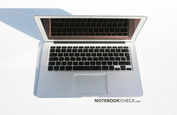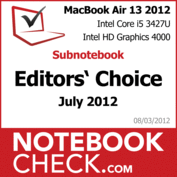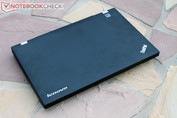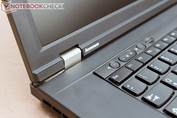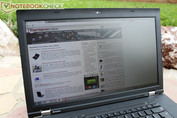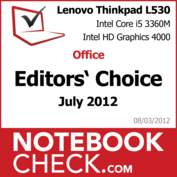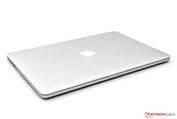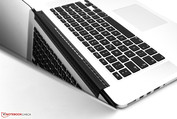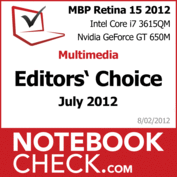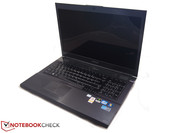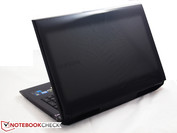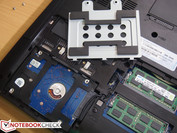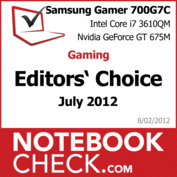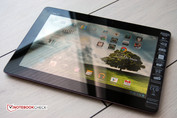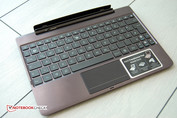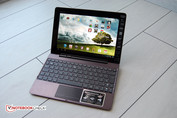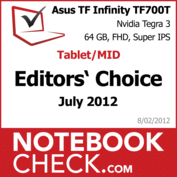Notebookcheck's Best of July 2012
We reviewed an astounding 31 "mobile devices" during the month of July 2012. No summer drought for our editorial staff this year. Manufacturers were busy pushing their summer offerings into stores. About 90% of that line-up was courtesy of Intel's Ivy Bridge. Especially Ultrabooks from Acer and Lenovo benefit from the low voltage version (ULV) of the processor. Less expensive subnotebooks feature the AMD E-series APU. But this time, some Ultrabooks can be had for as little as 600 Euro / $750 (like the IdeaPad U310).
Those interested in gaming will probably eye the GeForce GTX 660M, 675M, and 680M. The GTX 680M has the performance to support most gaming titles at their maximum settings and due to its features and requirements, it is mostly found in dedicated gaming rigs and desktop replacements (4 laptops in for review). The second largest group of test systems in July was business laptops like the Vostro, ThinkPad, Aspire V5, TravelMate and the LifeBook E-Serie (a total of 11 business laptops). Many fans of the traditional ThinkPads were taken aback when Lenovo changed their signature keyboard layout. Barring this change, as far as battery life and connectivity options are concerned, ThinkPads still score well. The only workstation this month is Lenovo's ThinkPad W530-N1K43GE which is rather expensive at 2300 Euro (~$2900) and it has no apparent weaknesses. The 95% gamut screen manages to almost fully cover the Adobe-RGB color space.
Acer's netbook Acer Aspire One 725 (equipped with the AMD C-Series C-60) which flew under the radar was the only one of its kind in the almost extinct netbook space. We couldn't wholeheartedly recommend the 11.6-inch system due to its glossy screen and fairly moderate battery life. We also reviewed the new AMD APU E2-1800 in the Sony Vaio SVE-1111M1E/P subnotebook.
Category Subnotebook
Contenders:
Apple MacBook Air 13 inch 2012-06 MD231LL/A 89%
Apple MacBook Air 11 inch 2012-06 MD223D/A 88%
Apple MacBook Pro 13 Mid 2012 86%
Lenovo IdeaPad U410-MAH6MGE 85%
Toshiba Satellite Z930-119 83%
There is always a lot of expectation surrounding the very successful MacBook Air 13 and we had the updated model in for review. The design, build quality, fit & finish, and overall feel of the unibody system are simply outstanding continuing in the same vein as the 2010 and 2011 models. Overall performance is up because of the upgraded SSD and improvement in battery life of the low-voltage Ivy Bridge processor (Core i5 3427U).
We also tested the MacBook Air 11 inch 2012-06 edition. The sibling of the MacBook Air 13 managed to score a "very good" in our review. Heat generation and lack of connectivity options are concerns here. The keyboard and the unibody chassis remain unchanged, while battery life has increased to about six hours. Apple fans sure will appreciate the attention to detail.
The competition never sleeps. On the Windows side, there is the Sony Vaio SV-S13A1Z9E/S. The system is small (13.3-inch form factor), yet very powerful. It features SSD-RAID, integrated UMTS/LTE, a carbon fiber chassis, and speedy input devices. The weak TN panel, however, offsets the premium features and causes the system to miss out on an excellent score.
When Apple updates one product, more are to follow. The MacBook Pro 13 Mid 2012 edition with the entry-level configuration (Core i5 3210M, HD Graphics 4000) is definitely more expensive than Windows laptops with comparable hardware, but it also features the famed unibody aluminum construction and a contrast-rich 1280x800 display panel. The above mentioned Vaio SV-S13A1Z9E certainly would benefit from a quality display like that the one in the Apple device. Because of the meager port selection and the high temperatures, the MacBook Pro 13 scored a "good" in our test.
Lenovo's answer to expensive Ultrabooks turns out as expected: affordable Ultrabooks! The 13.3-inch IdeaPad U310 is available for about 600 Euro (~$750) and the 14-inch IdeaPad U410 for 800 Euro (~$1000). Both feature a premium aluminum case and score well ergonomically (heat, noise level, input devices). Unfortunately, the displays are reflective and offer low contrast and poor viewing angles. The combination drive, consisting of a small caching SSD and large standard HDD, isn't perfect, but a usable compromise between speed and storage space.
Of course, systems under the headline "Ultrabook" also need to include the Toshiba Satellite Z930-119 (1200 Euro or $1500). The system's light weight is almost without equal in the 13.3-inch category. The fast SSD and the Ivy Bridge low voltage processor help overall performance. Unfortunately, weak input devices and an inferior TN display take away some of the joy.
Those who think that the various Apple, Vaio, and Lenovo subnotebooks are too expensive might be happier with the 11.6-inch AMD-Fusion APU offerings. The Lenovo ThinkPad X121e can be had for less than 500 Euro (~$630), but we just can't recommend the extremely gutless configuration with the AMD E-300. The low-cost ThinkPad has weak input devices and a case that's not very sturdy.
The build quality of the Sony Vaio SVE-1111M1E/P with AMD E-Series E2-1800 is not much better. The 11.6-inch system features a glossy display and an APU performance that's hardly improved. We think that 480 Euro (~$600) price is too expensive considering the competition. Those set on a Brazos APU should not spend above 400 Euro (~$500).
Subnotebook for the month of July 2012: Apple MacBook Air 13 inch 2012-06 MD231LL/A
No, it's not the perfect subnotebook. The processor performance gets throttled under load, and the reflective TN panel does not is not a premium feature. We don't need to say anything else about the fairly limited port selection, but for 1250 Euro (~$1600) a 3G module should have been included.
What we like
The performance gain is quite amazing. We are happy to report that design and build quality are still top-notch.
What we'd like to see
A better display would be a good thing. Brightness could be improved, and a matte finish would be nice.
What surprises us
The battery life of the MacBook Air is excellent and surpasses most Ultrabooks by a fair margin. And we thought runtime was supposed to be their main strength.
The Competition
Competition comes from within Apple itself: the more powerful MacBook Pro 13. Those needing an even more compact notebook should look at the MacBook Air 11. Other manufacturers also have some amazing products. Towards the top of the list are the Asus Zenbook Prime UX31A and the Sony Vaio SV-S13A1Z9E/S.
Category Business Notebooks
Contenders:
Lenovo Thinkpad L530 2479-3BG 86%
Lenovo ThinkPad T530 2429-5XG 85%
Acer TravelMate P643-MG-53214G75Mikk 84%
Lenovo ThinkPad T430 84%
Dell Vostro 3560 82%
Lenovo G585-M8325GE 81%
Acer Aspire 5250-E304G50Mnkk 76%
Acer Aspire 7739Z-P624650MNKK 73%
Lenovo’s Thinkpad L530 2479-3BG and Samsung’s 900X4C-A04DE go head to head, even though they are not exactly comparable. The no-frills and rather bulky 15.6-inch ThinkPad appeals to the business user not interested in appearances, but in functionality. The 900X4C, equipped with the Ivy Bridge low voltage processor, lures the mobile user with its design and slim chassis (and a weight of only 1.6 kilogram / 3.53 pounds). The prices are vastly different: about 2000 Euro (~$2500) for the 900X4C and less than 1000 Euro (~$1250) for the L530.
The upscale ThinkPad T530 2429-5XG business laptop is in familiar territory as far as build quality and rugged looks are concerned. The new chiclet keyboard with backlight does its job well. Slightly high heat emissions and the weight prevent a higher score. Even though the laptop features a good display panel and a high-performance Core i7 CPU, it missed a "very good" rating due to the aforementioned issues and a battery that doesn't fit snugly.
If the Thinkpad L530 or the T530 are too expensive, consider the Acer TravelMate P643-MG-53214G75Mikk. For about 900 Euro (~$1150), this system offers enough ports (including one for a docking station), a gaming-capable GPU (GeForce GT 640M), well-functioning input devices, and a rigid chassis. The P643 is an attractive option and trails the T530 by only one percentage point. However, those wanting many configuration options need to look elsewhere.
The Fujitsu Lifebook E782 holds its ground among the competition. The 15.6-inch system is not exactly cheap at 1100 Euro (~$1400), but has good display (decent viewing angles), low noise levels, convincing input devices, and many ports (including a docking port).
Lenovo's ThinkPad T430 appeals to the ThinkPad fans, as not too many things have changed. The build quality is convincing, the design practical, the battery life quite impressive, port selection ample, while noise levels are low. The TN panel suffers from low contrast but has a high resolution of 1600x900 pixels.
The Dell Vostro 3560 with the Radeon HD 7670M and Intel Core i5-3210M only costs about 770 Euro (~$1000). Instead of a stable NVIDIA NVS 5400M, this system features a consumer-oriented Radeon card. For those looking to play the occasional game, this should be of little concern.
The Lenovo G585-M8325GE (340 Euro/$425) is the low-cost leader among the eleven business laptops. Considering the price, the potential buyer shouldn't complain too much about the reflective TN panel or the low performance. The AMD-APU E-Series E2-1800 is probably better suited for subnotebooks. The low performance does have positive side effects: five hour battery life, low power consumption, low noise levels, and a chassis that stays cool.
Almost as inexpensive, but a lot thinner, is the Acer Aspire V5-531 for 400 Euro (~$500). The 15.6-inch system offers barely enough performance (Intel Pentium 967) and features a cheap-looking plastic case. Input devices are usable but not perfect. At least the port selection features USB 3.0.
Acer must have been a bit confused when they designed the Aspire 5250-E304G50Mnkk. Instead of an improved successor, we see cutbacks - no HDMI and the AMD E-Series E-300 APU is slower than the E450.
It's probably better to spend a little more for the Aspire 7739Z-P624650MNKK instead. At least it allows for quick surfing and speedy typing. Gaming is more or less out of the question (Intel Pentium P6200 - Arrandale), and battery life is way too short (1 hour 32 minutes).
Business notebook for the month of July 2012: Lenovo ThinkPad L530 2479-3BG
The Thinkpad L530 is neither as slim nor good looking as the Samsung Series 9, but for the money it offers better all-round business functionality. Docking port, Multi-Bay drive, and even a DisplayPort are some of the features a serious business user would want and available on the laptop.
What we like
Lots of ThinkPad for the money.
What we'd like to see
The feeling of having a work-horse that can take a beating.
What surprises us
Depending on the configuration, the L530 manages to get dangerously close to the upscale T530.
The competition
Business notebooks from other manufacturers. The Dell Vostro 3560, HP Probook 6570b and Lenovo's (more upscale) Thinkpad T530 which features better components.
Category Multimedia
Contenders:
Apple MacBook Pro Retina 15 inch 2012-06 88%
Asus N76VZ-V2G-T1011V 85%
Acer Aspire TimeLine Ultra M5-481TG-73514G25Mass 82%
Gigabyte P2542G 82%
Medion Erazer X6821 MD98054 82%
Samsung Serie 7 700Z3C-S01 82%
Gigabyte U2442N 81%
Medion Akoya P7815-MD98063 81%
Acer Aspire V5-571G-53314G50Makk 80%
Toshiba Satellite P855-107 80%
Toshiba Satellite U840W no score
The Apple MacBook Pro 15 Retina scored the most points. We tried not to get bedazzled by the resolution of 2880x1800 pixels, but rather subjected the Pro to thorough tests running both Mac OS and Windows. For further details please check our report here.
The Asus N76VZ-V2G-T1011V offers great sound quality, which is made possible by an external subwoofer. The Full-HD 17-inch laptop not only features a very good display, but also top notch build quality and low emissions. Aside from a jumpy touchpad and occasional GPU throttling, the N76VZ doesn't suffer from any major shortcomings. The GT 650M doesn't always manage Full-HD gaming with the current game selection, but is still a potent graphics card.
According to the editor, the Dell XPS 15 (L521X) offers "class-leading" build quality. In that regard, this system is one of the few that is able to keep up with Apple's unibody chassis. The input devices are also perfect, and the performance is on a very high level due to the Core i7-3612QM and the SSD/HDD hybrid drive. The GeForce GT 640M is probably not the first choice for those interested in playing games since throttling is an issue (games with high CPU load).
Sony's newest member of its ‘bread and butter’ series is the 14-inch Vaio-SV-E14A1M6EW (730 Euro/$915). The Radeon HD 7670M is an attractive option for casual gamers. The input devices appeal to the business user and six hours of battery life won't leave those working on the go stranded. Unfortunately, the TN panel is pretty weak and features washed-out colors.
The Samsung Series 5 550P5C-T02 is a system in the same league as the Vaio SV-E14A1M6EW and vies for the attention of the buyer with a GeForce GT 630M and a Core i5 processor. The JBL sound system emits surprisingly strong bass and the display panel is both matte and bright. Low contrast and reduced viewing angles don't work well for a multimedia machine, however.
The Acer Aspire Timeline Ultra M5-481TG features a low voltage CPU and a GeForce GT 640M LE. The 14-inch notebook is not an Ultrabook, even though the slim chassis, low weight, and the long battery life of six hours would lead you to believe so. Negative aspects are the low contrast display and the limited port selection.
The special edition of the 15-inch Dell Inspiron 15R (SE) features a good display (contrast, viewing angles) and decent input devices. The resilient surfaces can't hide the fact that the build quality leaves room for improvement. Mobility is also not the Inspiron's forte, since the battery life is fairly short at about three hours.
We don't come across Gigabyte laptops that often. The 15.6-inch Gamer P2542G has a lot going for it. The antiglare coated Full-HD panel offers high contrast and an outstanding display brightness of 355 cd/m². That coupled with the fast LiteOn SSD and the GeForce GTX 660M make for a nice gaming system. Under load, the system does suffer from excessive heat, however.
The fairly high price of the Gigabyte system (1530 Euro/$1920) might have some people look at cheaper systems like the Medion Erazer X6821. For 1150 Euro (~$1450), the system features a slightly better GeForce GTX 670M, but is hampered by a weaker HD panel. No SSD is available, but the laptop hides two 500 GB HDDs in the bulky chassis.
Because Samsung updated the CPU and installed a better graphics card (GeForce GT 630M) in the Series 7 700Z3C-S01, we subjected the laptop to another round of testing. The TN panel still suffers from low contrast, but the battery life and overall performance increased compared to the Sandy Bridge version. The high build quality of the aluminum chassis and a very good keyboard are the other plus points of this all-around system.
The U2442N is our second notebook from Gigabyte. It appears to be a member of the Ultrabook family, but does not come equipped with a low voltage processor with just an integrated graphics card. Instead, it features a Core i5-3210M and a GeForce GT 640M. Gaming enthusiasts would sure appreciate the machine, if it wasn't for the low contrast TN panel (non-glare), which also suffers from poor viewing angles.
Medion's 17-inch Akoya P7815-MD98063 is a multi-purpose all-round laptop with a GeForce GT 640M and a Core i7-3612QM CPU. The case appears to be of poor quality, the touchpad and keyboard offer mediocre feedback. It is too bad because the bright, matte contrast-rich panel would surely appeal to many potential buyers (900 Euro/$1150).
With the Aspire V5-571G, Acer created an extremely thin 15-inch laptop (not an Ultrabook), which costs only 600 Euro (~$750) and comes equipped with a ULV processor and a GeForce GT 620M. Gaming is possible without any issues, although high resolutions on external monitors are out of the question. Disadvantages are the bad panel (low contrast), and the lack of build quality.
The multi-purpose Asus K55VM-SX064V has a few things going for it (performance, emissions, battery life), but is not a stand-out in any area. "Average to good" describes the input devices, battery life, and gaming performance (GeForce GT 630M). We think the price (850 Euro/$1075) is too steep for a system with a low-quality TN panel and no Blu-ray drive.
The Toshiba Satellite P855-107 has better technical specs and comes with a GeForce GT 640M, This multi-purpose system offers a unique highlight: 3D without glasses (Nvidia’s 3D-Vision) and a superb speaker system. Unfortunately, outdoor use is limited because of strong reflections despite the high brightness. The slow conventional hard drive constrains performance and should be replaced with an SSD.
Since the Toshiba Satellite U840W we received was a pre-production sample, we did not enter it into the results. The first Ultrabook featuring a movie-like 21:9 aspect ratio is surely an interesting concept for the movie aficionados.
Multimedia notebook of the month of July 2012: Apple MacBook Pro Retina 15 inch 2012-06
Notwithstanding discussions about the price (2100 Euro/$2650), we think that the new panel is simply outstanding. Color space, viewing angles, brightness, and contrast are perfect.
What we like
The slimmer aluminum unibody chassis with superb rigidity, feel, and finish. The very high resolution of the Retina display, the test results, and the high performance of the internal components.
What we'd like to see
High DPI applications from third-party vendors, an easy method for cleaning the fans, lower temperature at the surface. Since the battery is glued in, a change will be costly.
What surprises us
That Apple is using a chassis that eliminates the possibility to upgrade (like the MacBook Air). More stuff to carry around: MagSafe and Ethernet adapter....and only two integrated USB ports. On the plus side, we were happy to see the inclusion of HDMI and USB 3.0 ports. The port selection is now up to date. Unfortunately there are only few Thunderbolt peripherals. The ones available are expensive and not very attractive for that reason.
The competition
In Apple's own portfolio, there is the MacBook Pro 15 Mid 2012 without the Retina display, the MacBook Pro 13 (which weighs about the same) and the more mobile MacBook Air 13 Mid 2012 edition. Both models are equipped with Intel Ivy processors. With the Windows OS, you have two notebooks, the Asus N56VZ and the MSI GT60 with powerful hardware for half the price, the Acer Aspire Timeline Ultra M3 with a slim chassis and 15.6-inch display. You could also consider the smaller Asus Zenbook Prime UX31A and UX32VD with 13.3-inch display and native Full-HD resolution.
Category gaming / DTR
Contenders:
One K73-2O 84%
Samsung Serie 7 Gamer 700G7C 84%
An inexpensive no-name product goes head to head with one from a top-tier manufacturer? This is what the comparison of the One K73-2O and the Samsung Series 7 Gamer 700G7C (1800 Euro/$2300) appears to be at first glance. The identical scores in the category DTR (desktop replacement)/gaming show the qualities of the much cheaper (1240 Euro/$1600 with SSD) notebook. While Samsung's gaming notebook pulls ahead in areas like 3D performance (GeForce GTX 675M), input devices, and fit and finish, the One K73-2O (GTX 660M) is better as far as battery life, heat emissions, and SSD speed is concerned.
Build to Order machines (BTO) can also get quite expensive. Case in point is the high-end configuration of the Devil 6700 from Deviltech. The 15.6-inch notebook features a GeForce GTX 680M, (at the time of writing this article) the most powerful single mobile GPU from Nvidia. Although the 1800 Euro price tag is not exactly a bargain, Devil includes an Intel SSD (520 series) and a very good Full-HD display for this price. Disadvantages are the very high noise level and the inferior input devices. We consider the latter a big no-no in this price bracket.
The MSI CX70-i789BW7H is a large all-round system with a GeForce GT 640M and Core i7-3610QM. The performance is quite good, but the conventional HDD slows the notebook down significantly. More reason for concern are the high temperatures (throttling up to system shutdown!), and the mediocre input devices. All in all, we just can't recommend this system.
Gaming notebook for the month of July 2012: Samsung Series 7 Gamer 700G7C
Our final decision is for the expensive Samsung and not the less expensive One K73-2O. Why? It is because on the K73-20, Turbo Boost does not function when the Nvidia GPU is active and the CPU gets throttled under load. Both are things the avid gamer would want to avoid.
What we like
Snazzy illumination with handy control interfaces.
What we miss
An SSD would have improved performance significantly.
What surprises us
That Samsung doesn't offer different configurations.
The competition
The Schenker XMG P702 with the same graphics card but many different configuration possibilities. The Alienware M17x R4 with the same CPU but more potent graphics cards. The Asus G75, the quiet high-end gaming system.
Category Tablet / MID
Contenders:
Asus Transformer Pad Infinity TF700T 90%
Low-priced budget product meets the expensive. We pit two 10-inch tablets which have not much in common besides Android 4.0 and Tegra 3 against each other. The Transformer Pad Infinity TF700T is a high end tablet which features a solid build quality and usability up to iPad 3 standards. Highlights are the great performance, outstanding IPS display (brilliant viewing angles, Full-HD), and the optional docking keyboard (with additional battery).
Acer's philosophy is different. The manufacturer seems to think that nobody would want to spend 700 Euro (~$900) for a tablet, no matter how sophisticated. The result is a tablet with Tegra 3, a good IPS panel (high contrast), and decent battery life for around 400 Euro (~$500). The disadvantages are apparent: bad speakers, high temperatures (even during idle), charging only via power adapter, and a warranty period of only 12 months.
Tablet / MID for the month of July 2012: Asus Transformer Pad Infinity TF700T
The price is up in iPad 3 territory, but the well-rounded system leaves nothing to be desired. Unless 3D shooting games are your forte, the tablet won't disappoint.
What we like
The list is too long, so we will only mention the most important features: the Super IPS panel is a delight, high performance ensures longevity, and the great build quality leaves no reason for complaint.
What we'd like to see
Better cameras, although they are not an important feature on tablets. A 3G or LTE module should be on board - or at least an option.
What surprises us
The Asus Transformer Pad Prime TF201 was already a great tabled ranking near the top in the tablet segment. There is no question that Asus upped the ante with the Infinity.
The competition
The view from the top is lonely. This old adage fits well when we talk about the Asus Transformer Pad Infinity TF700T and its competitors. High performance luxury tablets are Apple's New iPad, and Asus' own TF300T and the Prime TF201. The Acer Iconia Tab A510 is another great performer which shows that the manufacturer knows how to build tablets, as well.




